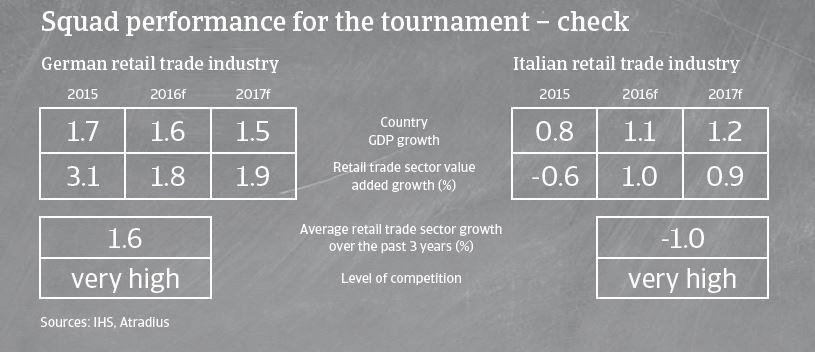German non-food retailers struggle to cope with the fast growing market leaders, while the rebound for their Italian peers remains modest.
European football championship 2016
Sector playing field: consumer durables retail

Germany: smaller players continue to struggle
According to the German Statistics Office, non-food retail turnover increased 3.0% year-on-year in 2015, and further growth is expected in 2016. German consumer durables retail benefits from the country´s robust economic performance, with household consumption expected to grow 2.1% in 2016 following the 1.9% growth registered in 2015.
In all German consumer durables retail segments a concentration process is on-going, with a few large retail chains generating the majority of sales. Therefore, smaller and mid-sized retailers are still struggling to cope with the fast growing market leaders. At the same time, they are facing additional pressure from online retailers. The best way for smaller retailers to survive in this very competitive market is to join a large purchasing association.
Price transparency, made available to consumers by online retailers, maintains pressure on margins along the whole value chain.Italy: just a modest rebound - in contrast to the Squadra Azzura
It is expected that Italian consumer durables retail will grow modestly in 2016, as private consumption is forecast to increase 1.2% after growing 0.9% in 2015. Both demand and profit margins are expected to remain stable.
Competition in the consumer durables retail sector is very high, and this is leading to market adjustments: weaker players with poor financial strength have disappeared while some businesses chose to merge with their peers in order to survive. The on-going concentration process is expected to continue until a new balance is reached in the market (compared with many other EU countries, Italian retail businesses are, on average, small). The share of online sales is increasing further.
Players to watch
Germany

According to the research institute GfK, in 2015 sales of large electric domestic appliances increased 4.4%, to EUR 8.7 billion, while sales of small electric domestic appliances rose 9.9%, to EUR 4.2 billion. GfK expects sales growth of those items to continue in 2016, due to low inflation and decreased fuel prices as well as a robust job market.
For the furniture segment, the German association of furniture industries BVDM recorded a turnover increase of 4.2% in 2015, reaching EUR 32.6 billion. In 2016 it is expected that sales will again amount to more than EUR 32 billion.

Textiles sales just levelled off in 2015 compared to 2014.
Italy

In the household appliances segment a modest rebound was registered in 2015, partially sustained by some public incentives for the replacement of white goods.

Due to its dependence on real estate, the furniture subsector has suffered yearly declines until 2014, despite decreasing sales prices (down 40% over the last six years). A rebound started in 2014, but is still insufficient to compensate for the decline seen in previous years.
Special attention is paid to fraud issues that occur in the electronics retail segment, with some small businesses reporting very good financial results while the performance is not in line with the industry trend.
Major strengths and weaknesses

German consumer durables industry: strengths

Italian consumer durables industry: strengths
- Many long-established, financially strong family businesses
- Experienced and reliable management
- Economic recovery of demand after years of subdued performance
- Increased consumer confidence
- On average financial gearing of businesses is not overly high

German consumer durables industry: weaknesses

Italian consumer durables industry: weaknesses
- Strong competition for brick-and-mortar from e-commerce
- Highly dependent on consumer sentiment
- Smaller players are generally more exposed to risks due to larger players dominating the market
- Smaller players often lack the critical mass for long-term survival
- Highly competitive environment
- Increasing pressure from the e-commerce segment
Fair play ranking: payment behaviour and insolvencies
German consumer durables industry
In general, payment terms in the consumer durables retail segment range from 30 days to 60 days, however they can extend to more than 120 days depending on the market power of individual retailers.
Payment behaviour in the German consumer durables sector has so far remained both good and stable, and we expect no major changes, as the general outlook for all subsectors is positive.
The sector´s insolvency level is low, and no increase is expected in 2016.
When businesses cannot pass on increased costs to customers/consumers or compensate for this with savings elsewhere, they might demand extended payment terms.
Italian consumer durables industry
Payment terms generally range from 60 to 90 days.
Payment delays decreased in the H2 of 2015, but have levelled off since then
Insolvencies have not increased in 2015, and are expected to remain stable in 2016
Downloads

3.05MB PDF
